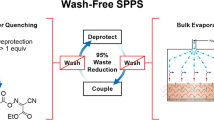Abstract
Fast and precise heating by microwave irradiation during solid-phase peptide synthesis (SPPS) can reduce reaction times as well as provide better purities and greater yields for the synthesis of difficult peptides. Microwave- assisted SPPS has proven to be a useful and reliable tool for the synthesis of peptides as well as small proteins. It is particularly well suited for sequences with a high propensity to form β-sheet-type structures and for sterically difficult couplings. In this protocol, conditions and detailed procedures are described for performing microwave-assisted SPPS using the Syro Wave™. Here we describe the synthesis of two difficult peptide sequences: the first is derived from the C-terminus of the MuLV CTL epitope, the second is a de novo designed peptide with a C-terminal alkyne.
Access this chapter
Tax calculation will be finalised at checkout
Purchases are for personal use only
Similar content being viewed by others
References
Bacsa B, Desai B, Dibó G, Kappe CO (2006) Rapid solid-phase peptide synthesis using thermal and controlled microwave irradiation. J Pept Sci 12:633–638
Brandt M, Gammeltoft S, Jensen KJ (2006) Microwave heating for solid-phase peptide synthesis: general evaluation and application to 15-mer phosphopeptides. Int J Pept Res Ther 12:349–357
Erdélyi M, Gogoll A (2002) Rapid microwave-assisted solid-phase peptide synthesis. Synthesis 11:1592–1596
Matsushita T, Hinou H, Kurogochi M, Shimizu H, Nishimura S (2005) Rapid microwave-assisted solid-phase glycopeptide synthesis. Org Lett 7:877–880
Pedersen SL, Sørensen KK, Jensen KJ (2010) Semi-automated microwave-assisted SPPS: optimization of protocols and synthesis of difficult sequences. Biopolymers 94(2):206–212
Malik L, Tofteng AP, Pedersen SL, Sørensen KK, Jensen KJ (2010) Automated “X-Y” robot for peptide synthesis with microwave heating: application to difficult peptide sequences and protein domains. J Pept Sci 16:506–512
Bacsa B, Kappe C (2007) Rapid solid-phase synthesis of a calmodulin-binding peptide using controlled microwave irradiation. Nat Protoc 2:2222–2227
Pedersen SL, Tofteng AP, Malik L, Jensen KJ (2012) Microwave heating in solid-phase peptide synthesis. Chem Soc Rev 41(5):1826–1844
Wohr T, Wahl F, Nefzi A, Rohwedder B, Sato T, Sun X, Mutter M (1996) Pseudo-prolines as a solubilizing, structure-disrupting protection technique in peptide synthesis. J Am Chem Soc 118:9218–9227
Yamashiro D, Blake J, Hao Li C (1976) The use of trifluoroethanol for improved coupling in solid-phase peptide synthesis. Tetrahedron Lett 17:1469–1472
Seebach D, Thaler A, Beck A (1989) Solubilization of peptides in non-polar organic solvents by the addition of inorganic salts: facts and implications. Helv Chim Acta 72:857–867
Thaler A, Seebach D, Cardinaux F (1991) Lithium-salt effects in peptide synthesis. Part II. Improvement of degree of resin swelling and of efficiency of coupling in solid-phase synthesis. Helv Chim Acta 74:628–643
Palasek S, Cox Z, Collins J (2007) Limiting racemization and aspartimide formation in microwave-enhanced Fmoc solid-phase peptide synthesis. J Pept Sci 13:143–148
Bacsa B, Horvati K, Bosze S, Andreae F, Kappe CO (2008) Solid-phase synthesis of difficult peptide sequences at elevated temperatures: a critical comparison of microwave and conventional heating technologies. J Org Chem 73:7532–7542
Dolling R, Beyermann M, Haenel J, Kernchen F, Krause E, Franke P, Brudel M, Bienert M (1994) Piperidine-mediated side product formation for Asp(OBut)-containing peptides. J Chem Soc Chem Commun 853–854.
Wade J, Mathieu M, Macris M, Tregear G (2000) Base-induced side reactions in Fmoc-solid phase peptide synthesis: minimization by use of piperazine as N-alpha-deprotection reagent. Lett Pep Sci 7:107–112
Coantic S, Subra G, Martinez J (2008) Microwave-assisted solid phase peptide synthesis on high loaded resins. Int J Pep Res Ther 14:143–147
Bacsa B, Horváti K, Bosze S, Andreae F, Kappe CO (2008) Solid-phase synthesis of difficult peptide sequences at elevated temperatures: a critical comparison of microwave and conventional heating technologies. J Org Chem 73:7532–7542
Redemann T, Jung G (1996) In situ fluoride activation allows the preparation of peptides not accessible by routine synthesis protocols. In: Ramage R, Epton R (eds) Peptides, Proceedings of the 24th European Peptide Symposium, pp 749–750
Carpino LA, Krause E, Sferdean CD, Schümann M, Fabian H, Bienert M, Beyermann M (2004) Synthesis of “difficult” peptide sequences: application of a depsipeptide technique to the Jung-Redemann 10- and 26-mers and the amyloid peptide Ab(1-42). Tetrahedron Lett 45:7519–7523
Ogihara NL, Weiss MS, Degrado WF, Eisenberg D (1997) The crystal structure of the designed trimeric coiled coil coil-VaLd: Implications for engineering crystals and supramolecular assemblies. Protein Sci 6:80–88
Author information
Authors and Affiliations
Editor information
Editors and Affiliations
Rights and permissions
Copyright information
© 2013 Springer Science+Business Media, New York
About this protocol
Cite this protocol
Malik, L., Jensen, K.J. (2013). Microwave-Assisted Solid-Phase Peptide Synthesis Using the Biotage Syro Wave™. In: Jensen, K., Tofteng Shelton, P., Pedersen, S. (eds) Peptide Synthesis and Applications. Methods in Molecular Biology, vol 1047. Humana Press, Totowa, NJ. https://doi.org/10.1007/978-1-62703-544-6_16
Download citation
DOI: https://doi.org/10.1007/978-1-62703-544-6_16
Published:
Publisher Name: Humana Press, Totowa, NJ
Print ISBN: 978-1-62703-543-9
Online ISBN: 978-1-62703-544-6
eBook Packages: Springer Protocols



